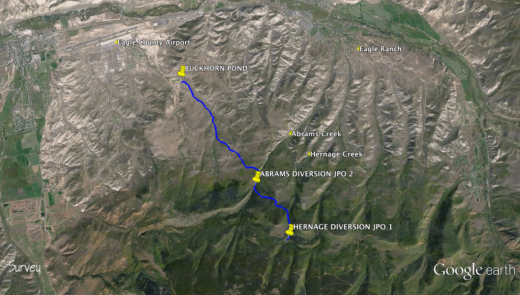Plan to protect Abrams Creek trout
TU, CPW, Buckhorn Valley Metro announce plan to protect Abrams Creek trout
Date: Thu, 07/14/2016 For Immediate Release
Contact: Mely Whiting, mwhiting@tu.org, (720) 470-4758
Kendall Bakich, kendall.bakich@state.co.us, (970) 355-4771
Preserving rare cutthroat population a high priority for state conservation efforts
(Eagle)—Trout Unlimited, Colorado Parks and Wildlife and the Buckhorn Valley Metropolitan District No. 1 (District) today announced plans for an ambitious restoration project on Abrams Creek to preserve a rare population of cutthroat trout threatened in part by reduced flows during irrigation season.
The small population of native Colorado River cutthroat trout in Abrams Creek is genetically unique and the only native trout population in the Eagle River watershed. CPW has called the population the “highest priority” for cutthroat conservation efforts in western Colorado.
Under the agreement reached among Buckhorn Valley, which irrigates with water from Abrams Creek, Colorado Parks and Wildlife (CPW), and Trout Unlimited, the partners would work to improve flow conditions for the cutthroat population while honoring the District’s water rights and irrigation needs. The increased flows are expected to increase the resident cutthroat trout population by enhancing quality habitat, improving food resources and boosting reproductive success.
“This is a great example of diverse water stakeholders coming together to find a pragmatic, collaborative solution,” said Mely Whiting, counsel for Trout Unlimited. “This agreement shows that we can manage water in ways that honor senior water rights while maintaining the health of our rivers and streams.”
Currently, Abrams Creek is subject to water diversions that can remove a significant portion of the stream during the irrigation season that begins annually on April 1. Abrams Creek’s natural flows range from 11 cfs to 0.5 cfs during the irrigation season. The District owns 3 cfs of senior water rights in Abrams Creek, which is diverted to irrigate lands in Buckhorn Valley. An estimated 40 percent of the diverted water does not reach the irrigated lands due to leakage from the ditch. The partners propose to pipe portions of the JPO 2 ditch to improve the efficiency of delivery (see map). These infrastructure upgrades would reduce the Buckhorn’s diversions from Abrams Creek by an estimated 40 percent, leaving an average of 300 acre-feet more water per year in Abrams Creek for the benefit of the cutthroat trout population. The District would also agree to cease diversions from Abrams Creek when flows in the creek drop below 1.25 cfs.
Among other benefits, increased flows are expected to:
- Increase physical/wetted habitat and riparian cover along approximately 3.5 miles of stream.
- Improve in-stream habitat connectivity and quality, allowing trout to more easily move to the best habitat and holding areas.
- Enhance sediment transport, which helps keep river cobble and spawning habitat clean and healthy.
- Increase aquatic insect productivity, improving cutthroat food resources.
- Create deeper pools for trout refuge.
- Maintain cooler water temperatures in lower Abrams.
Moreover, a permanent fish screen will be installed at the point of diversion on Abrams Creek that will help protect the trout population by reducing losses due to entrainment in the ditch.
“Summer and fall low flow periods are hard on cutthroat trout due to the increased water temperatures and limited pool and holding waters,” said Kendall Bakich, aquatic biologist for CPW. “By decreasing the water diversions, we can increase stream flows and expand the amount of wetted habitat downstream of the diversion. This will give this high-value trout population a much better chance of survival.”
“We’re pleased to be able to work with Trout Unlimited and CPW on infrastructure improvements that will improve delivery of water while benefiting stream habitat,” said Scott Green, board member of the District. “The District believes this project will be a win-win for everyone involved.”
Successful completion of the project will require significant fundraising efforts and outreach to partners, potentially affected parties, and the public, as well as agency approvals from the BLM and the U.S. Army Corps of Engineers, among others.
Read more http://www.tu.org/press-releases/tu-cpw-buckhorn-valley-metro-announce-p...


